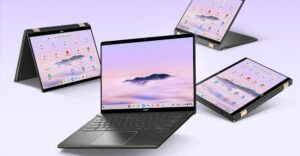
There is no rest for the wicked, or anyone else this summer, as last week had a number of big events.
One of the largest is that Acer moved around Lenovo and Apple (which is also coming up fast) to become the No. 3 PC manufacturer by buying Gateway.
For those who wanted an iPhone but couldn’t afford it, Nokia has stepped up to the plate — but the really big news is that Google is getting closer with what really could be an iPhone killer. In addition, it is probably based at least partially on Microsoft technology. The strategy behind that really showcases Google’s brilliance.
Finally we’ll have my product of the week: A PC solution that makes the US$100 laptop for every child thing (which is actually closer to $200) look expensive. This one is running about $60, cutting a broad swath through education both domestically and in emerging markets.
Acer: On the Map With a Vengeance
Acer has been quietly building solid products and getting strong gains for some time now. As most of you who read me know, I have an affinity for the AMD-based Ferrari notebooks it makes.
Coming up behind them is Asus which, coincidently, has a Lamborghini line based on Intel that I understand is also very nice.
Last week, Acer moved to buy Gateway, and the PC world was changed again.
Acer has been trying to grow into the European and U.S. markets aggressively, but has run into problems acquiring the shelf space it needed to sell its products.
HP, Gateway, Toshiba and Sony have simply not given up the space needed for Acer to expand as it wants.
The Packard Bell Factor
Lenovo, the powerhouse PC company out of China, wasn’t making things easy and was out-bidding Acer for Packard Bell in Europe, Acer’s planned path to shelf space there.
So Acer evidently decided to kill two birds with one stone and acquired Gateway, which had the right of first refusal on any Packard Bell sale (thanks to an old noncompete with the new owner of Packard Bell). You don’t see one of these martial-arts plays that often, and this appears to have been very well played.
I doubt Lenovo is going to let this lie though, and will likely ramp up its own efforts in retail in response. The stories surrounding all of this are fascinating.
Corporate? No Thanks
What is interesting is Acer apparently doesn’t want Gateway’s corporate lines — it just wants the consumer products and retail presence.
The corporate PC market has been relatively flat and very low-margin for some time now, and it was the consumer and SMB (small and medium-sized business) segments that helped push HP ahead of Dell earlier this year.
This likely sets up a an increasing possibility that companies will shift to more of a cell phone-like strategy and use something like Mojopac or a Virtual Machine product to allow employees to purchase their own PCs.
This trend is actually very advanced in education, which was one of Gateway’s largest — and historically most successful — segments.
Improving Its Reputation
Acer has had a bad reputation for quality going back several years. More recently, product quality has been fine, but many likely remember the past. Fortunately, Gateway’s quality reputation is unmatched, and that should help the merged company here in the U.S. rather nicely.
For those of you who are wondering about Packard Bell, it actually is a very successful company in Europe and, in contrast to its reputation in the U.S., well-regarded there.
In the end, we have a new power player on the block, one of the most aggressive in terms of design and delivering strong products at aggressive prices. Assuming it can pull this merger off — and mergers like this aren’t easy — the result should be very powerful.
The iPhone Competition Ramps Up
A few weeks ago, I suggested the iPhone may be Apple’s Pearl Harbor because it had really gotten the attention of a number of companies that couldn’t have cared less about Apple in the PC market or the MP3 market in general. My expectation was we would start to see aggressively competitive products shortly — and shortly has arrived.
Lower-cost, unlocked clones of the iPhonemay show up in China, according to Popular Science, but those will likely violate Apple’s intellectual property rights, and we won’t see many of them here.
More interesting is the phone that Nokia is bringing to market. Unlike Apple, Nokia has been building phones for years and, unlike Motorola, Nokia is actually still doing very well. Check out this video and you’ll realize that Nokia has no problem taking what Apple has done and making it its own.
Here is an ABC news story on the entire line, but the top end is unlocked, has a better camera, and the battery issue appears to be resolved.
Choose Your Network
For those of you that don’t get this, while it seems like it is more expensive, Nokia is shipping these phones unlocked, so this price is without a subsidy. You can pick your carrier and you can get a plan cheaper than the $130-a-month plan that has caused some to turn their iPhones into iPods.
However, the really interesting product is that HTC phone being made for Google’s Free (or really cheap) phone service.
Set for Q1 2008, according to the reportedly confirmed but unnamed HTC executive, this phone will have much of what the iPhone has and, given it will be advertising subsidized, it will cost a fraction of what the iPhone costs.
Google’s Scary Brilliance
When I say fraction, Google execs have been talking free, though I expect there will be some initial charge, and they likely won’t be paying for all of your calls.
Even more interesting is that HTC is exclusively based on Microsoft’s mobile platform, which means Google is moving against Apple on Microsoft, which is twisted in so many ways. It is, however, consistent with Google, which has mastered the art of trivializing its competitors.
In many ways Google’s brilliance is kind of scary as it games Linux, Intel, Microsoft and Apple, taking from all and walking away with the profits. This company makes the “Pirates of Silicon Valley” look like pussies.
This is going to be fun to watch.
Product of the Week: The $60 PC for Education
NComputing, run by the first ex-eMachines CEO, has a really interesting shared computer architecture that is evidently cutting right through both the education market in the U.S. and in emerging Eastern Bloc countries.
We’ve known for some time that the performance we are buying is generally more than we can use, unless we are doing high-end gaming or heavy analysis.
The NComputing solution has two versions. The lowest cost uses hard-wired, solid-state terminals, which allow up to seven users to work off a single current-generation low-cost (sub-$500) PC concurrently.
The higher-end solution allows up to 10 users, connected over Ethernet, to connect a similar computer or up to 30 if you host on a server. Often these are actually deployed by teachers.
A Boon for Linux
This is the solution that was used to get 11,000 delegates at the World Trade Organization connected back in 2005, both showing that the solution isn’t new and that it scales — man, it really scales.
What is amazing is that for most of the activities you or I do — including word processing, browsing the Web, email and even casual games — this actually works very well.
While the solution works with Windows, it appears the majority that have been sold are based on Linux. The overall solution may represent one of the strongest opportunities Linux has on the desktop.
This is because kids grow up, and if they get comfortable with Linux as kids they’ll likely be comfortable with Linux as adults. The solution is already getting into business.
Who says the desktop is dead?
Rob Enderle is a TechNewsWorld columnist and the principal analyst for the Enderle Group, a consultancy that focuses on personal technology products and trends.




















































Glad PSP Video Converter is a powerful PSP MPEG4 video converter/PSP burner with fast working speed in burning movie to PSP and downloading movie to PSP.You can get this PSP MPEG4 video converter at a very competitive price.